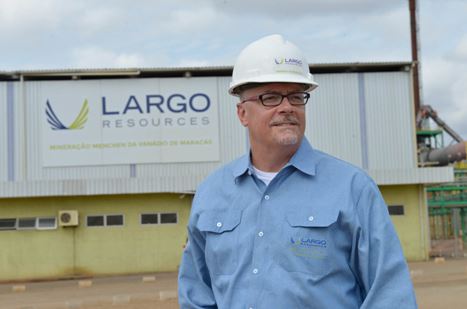Renewable Energy Sector Demands High Grade Vanadium

Mark Smith, CEO, Largo Resources, at Maracas Menchen Mine.
CORPORATE PROFILE
Largo Resources Delivers Highest Grade, Lowest Cost Vanadium
As our world is shifting to a renewable energy economy, how will we be able to store the energy we need to power the globe? The answer lies with energy storage. According to the U.S. Energy Storage Monitor, energy storage demand, especially at the business and utility scales, will increase ten times in the next five years and interest in flow batteries is increasing, especially for applications in remote areas and for enhancing grid stabilization.
“The best utility-scale battery storage technology to arise on the commercial market is the vanadium redox battery, also known as the vanadium flow battery,” says Mark Smith, CEO, Largo Resources Ltd. (LGO-TSX) which produces the highest grade, lowest cost vanadium at its Maracás Menchen Mine in Brazil. Vanadium flow batteries (VRB) have an operational lifetime that is double that of lithium ion. Testing has shown that VRBs have 200,000 charging and discharging cycles, with research suggesting an infinite lifetime.

Vanadium redox batteries demand a steady supply of vanadium to make the technology work. One vanadium redox battery requires six to eight kilograms of vanadium per kilowatt hour, so a 10 megawatt per hour battery requires 60 to 80 tonnes of vanadium. With a geographical concentration of vanadium producers in South Africa, Russia and China that have been disrupted by labor unrest, vanadium end users that are worried about a disruption of supplies are comforted to learn about Brazil and its role as a vanadium producing powerhouse. With a stable workforce and welcoming government, Largo Resource’s Brazilian-based Maracas mine has become one of the most important vanadium properties in the world.
Largo’s Maracás Menchen Mine set a new monthly production record in December 2017. The company produced 903 tonnes of vanadium pentoxide in December, surpassing by 15 tonnes the company’s previous monthly production record of 888 tonnes set in August 2017. Concurrently with these new production records, the average price range of V205 for the week ending December 29th 2017, was US $9.60/lb which represents an approximate 273% increase over the US$3.51 average price for V205 in Q3 2016 according to Metal Bulletin.
“As the producer of the highest grade, lowest cost vanadium available in the world, we want to ensure the availability of our vanadium electrolyte resource to leading developers of Vanadium Redox Flow Batteries,” says Smith.
Why is vanadium the critical element of choice preferred by the energy storage sector? While lithium ion batteries can last for many hours in small applications such as cell phones and laptops, they are limited in their effective duration to one to two hours in large, grid scale applications. This limits lithium ion to such uses as frequency regulation and voltage regulations while the inherent technology advantage of a flow battery makes them perfect for the following multi-hour storage applications:
- Commercial and Industrial Buildings -load leveling and UPS for critical mission facilities
- Microgrids – adding flexible capacity to both grid-tied and “island” microgrids
- Integrating solar and wind – shaping, firming and time-shifting renewables
- Grid optimization – increasing efficiency of current infrastructure.
Vanadium flow batteries are distinguished from fuel cells by the fact that the chemical reaction involved is reversible – meaning that that they can be recharged without replacing the active chemicals. Also, vanadium is the only element that allows a battery to have the same metal on both the positive side and the negative side. This means that there is no chemical reaction at the electrodes such as in a lithium ion battery which causes degradation with every charge and discharge cycle – limiting the life to five to seven years. As there is only an ionic reaction in a vanadium flow battery, there is no degradation in the electrolyte resulting in a twenty+ year life span with little loss of capacity.
A crucial factor in the vanadium flow battery is that, in contrast to rechargeable secondary batteries, the power and energy density are independent of each other, making them a more easily scalable technology. Nearly an unlimited capacity is attainable simply by using larger storage tanks, which can be left completely charged or discharged for extended periods of time with no negative effects, making it perfect for UPS backup and dispatchable power solutions for facilities.
Approximately ninety percent of vanadium produced globally is used as a steel additive. Vanadium forms stable nitrides and carbides, resulting in a significant increase in the strength the steel. When steel has just a fraction of a percent of vanadium in it, the overall strength can be increased by up to one-hundred percent. High strength, low alloy steels containing vanadium are used for the construction of buildings, bridges, pipelines, cranes, ships, rail cars, truck bodies, and auto and truck parts.
Vanadium also plays a crucial role in many titanium applications where it is used at a much higher addition rate than in steel (four percent compared to less than one percent). With its large aerospace industry, the U.S. share of vanadium consumption devoted to titanium alloys is more than double that in the rest of the world. Approximately nine percent of annual vanadium use in the U.S. is used for titanium applications and these uses are growing at a faster rate than many other applications, particularly now with Boeing’s 787 Dreamliner being in full production. More importantly due to the critical nature of the applications, the vanadium used must be of high purity and traced back to the source making most sources of vanadium unusable and creating an excellent market opportunity for high purity product that is produced by Largo Resources.

